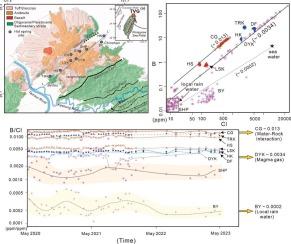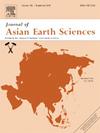Hydrogeochemical characteristics and the monitoring from 2020 to 2023 of hot spring waters in Tatun Volcanic Group, Taiwan
IF 2.4
3区 地球科学
Q2 GEOSCIENCES, MULTIDISCIPLINARY
引用次数: 0
Abstract
The Tatun Volcanic Group (TVG) is considered potentially active as indicated by the chemistry of fumarole gases and seismological data. The presence of magma volatiles in thermal water serves as a key signal of volcanic activity, making their monitoring crucial. However, other factors such as water–rock interactions can markedly obscure the water chemistry. The hydrogeochemical understanding of each hot spring site is essential in clarifying the source of components in hot springs. Based on the knowledge, the changes sourced from magma volatiles can be identified and help efficient monitoring of volcanic activities. In this study, nine spatially distributed hot spring sites were observed and monitored for 3 years in TVG. The monitored items include pH and major ions SO42-, Cl-, concentrations of total B, Na, Mg, Ca, K, Si, Al, Fe, Sr, Ba, ΣRFE, along with their ratios (B/Cl-, Cl-/SO42-). Additionally, strontium isotope ratios (87Sr/86Sr), hydrogen isotopes (δ2H), and oxygen isotopes (δ18O) were also measured, albeit at a lower frequency. Based on the field observation and the comprehensive geochemical observation, we fully discussed the hydrogeochemical characteristics of each hot spring site. Recommendations are provided along with a database of three years’ worth of monitoring results, offering valuable information for future monitoring efforts.

台湾大屯火山群温泉水水文地球化学特征及2020 - 2023年监测
根据喷气孔气体的化学性质和地震资料,认为大屯火山群具有潜在的活动性。热水中岩浆挥发物的存在是火山活动的关键信号,因此对它们的监测至关重要。然而,其他因素,如水岩相互作用,可以明显地模糊水的化学性质。对各温泉点的水文地球化学认识是弄清温泉成分来源的必要条件。基于这些知识,可以识别源自岩浆挥发物的变化,并有助于有效地监测火山活动。本研究对TVG 9个空间分布的温泉点进行了3年的观测和监测。监测项目包括pH、主要离子SO42-、Cl-、总B、Na、Mg、Ca、K、Si、Al、Fe、Sr、Ba、ΣRFE浓度及其比值(B/Cl-、Cl-/SO42-)。此外,锶同位素比值(87Sr/86Sr)、氢同位素(δ2H)和氧同位素(δ18O)也被测量,尽管频率较低。在野外观测和综合地球化学观测的基础上,充分探讨了各温泉点的水文地球化学特征。在提供建议的同时,还提供了一个三年监测结果的数据库,为今后的监测工作提供了宝贵的信息。
本文章由计算机程序翻译,如有差异,请以英文原文为准。
求助全文
约1分钟内获得全文
求助全文
来源期刊

Journal of Asian Earth Sciences
地学-地球科学综合
CiteScore
5.90
自引率
10.00%
发文量
324
审稿时长
71 days
期刊介绍:
Journal of Asian Earth Sciences has an open access mirror journal Journal of Asian Earth Sciences: X, sharing the same aims and scope, editorial team, submission system and rigorous peer review.
The Journal of Asian Earth Sciences is an international interdisciplinary journal devoted to all aspects of research related to the solid Earth Sciences of Asia. The Journal publishes high quality, peer-reviewed scientific papers on the regional geology, tectonics, geochemistry and geophysics of Asia. It will be devoted primarily to research papers but short communications relating to new developments of broad interest, reviews and book reviews will also be included. Papers must have international appeal and should present work of more than local significance.
The scope includes deep processes of the Asian continent and its adjacent oceans; seismology and earthquakes; orogeny, magmatism, metamorphism and volcanism; growth, deformation and destruction of the Asian crust; crust-mantle interaction; evolution of life (early life, biostratigraphy, biogeography and mass-extinction); fluids, fluxes and reservoirs of mineral and energy resources; surface processes (weathering, erosion, transport and deposition of sediments) and resulting geomorphology; and the response of the Earth to global climate change as viewed within the Asian continent and surrounding oceans.
 求助内容:
求助内容: 应助结果提醒方式:
应助结果提醒方式:


